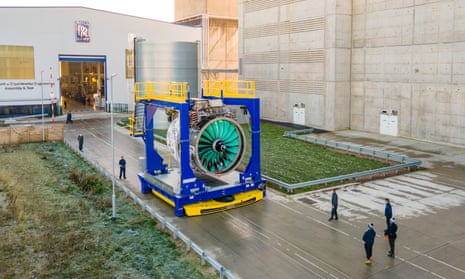After the new chief executive Tufan Erginbilgic’s dramatic description of Rolls-Royce as “a burning platform”, the actual numbers for 2022 were almost encouraging – or, at least, better than forecast. In place of the previously promised “modest” positive cashflow, Derby’s finest engine-maker produced £505m, which is not small change even in the context of a group of this size.
Meanwhile, commercial aircraft are flying again, especially in China, which is critical for Rolls-Royce. And it is obviously a good moment to own a business in the defence sector.
With the share price surging by a fifth on Thursday, one can reasonably ask why Erginbilgic felt the need to ramp up the rhetoric. Shouldn’t he have spent more time giving thanks for the efforts of his predecessor, Warren East, who genuinely had to reach for the fire hoses when the pandemic savaged Rolls’s revenues from servicing engines?
Erginbilgic’s answer on that point was twofold. First, he was trying to gee up the workforce. Fair enough – that’s the prerogative of a new boss. Second, and more pertinently, Rolls’s financial performance is still a shocker if you take the long view.
On that score, he is undoubtedly correct. Nobody had a good time in the pandemic but not every rival produced a five-year shareholder return of minus 67%. And an average annual return on capital of 4%-ish is a road to ruin if, like Rolls, you are borrowing in debt that still isn’t ranked as investment grade.
So, yes, a full toot on the transformation trumpet was in order. The aim is “materially higher profit, cashflows and returns”.
The tricky bit is making it happen. The insight that Rolls is “capable of much more” is hardly novel. Go back to East’s opening pitch on arrival in 2015, a period after a string of profits warnings, and you’ll find similar plain-speaking refrains. The talk then was about making “fundamental changes” to the company’s way of working and injecting “greater pace and accountability to decision making”.
Erginbilgic’s seven “workstreams” towards self-improvement don’t sound markedly different in spirit. It’s fine, for example, to say you want to improve “commercial optimisation” and be rewarded properly for “the value we create for customers”, but who doesn’t?
Those same customers, one assumes, will also be keenly aware of their negotiating clout. In a similar vein, the goal of delivering “a significant and structural” reduction in working capital has been heard before at Rolls.
If there’s a difference in Erginbilgic’s approach, it’s the promise to make the strategy “granular”. There may also be a certain new ruthlessness about chopping programmes with marginal paybacks. The UK government, for example, should take note of the demand to actually commit to a funding model for small, modular nuclear reactors, a business that excited East.
Yet the ambition will only start to feel real when Erginbilgic issues hard targets of Rolls’s financial ambitions and puts a few numbers of what he thinks is achievable. That moment is promised for the second half of this year and is the critical first stage of this latest reinvention effort. He’s not there yet.
after newsletter promotion
The good news for shareholders is that gentler breezes are blowing through the aerospace business, where the civil side represents 45% of Rolls’s group revenues of £12.7bn.
The moment of maximum danger from pandemic fallout has clearly passed if the forecast proves correct that engine flying hours in 2023 will be 80%-90% of 2019 levels.
But investors could, for the time being, contain their enthusiasm for the idea that Rolls can move seamlessly to a higher glide path. The aerospace business remains capital-intensive and volatile; and net zero would seem to carry as many threats as opportunities.
A sweeping review of operations is justified at this juncture and Erginbilgic is saying the right things – but he’s not the first to promise that the future will be better.

